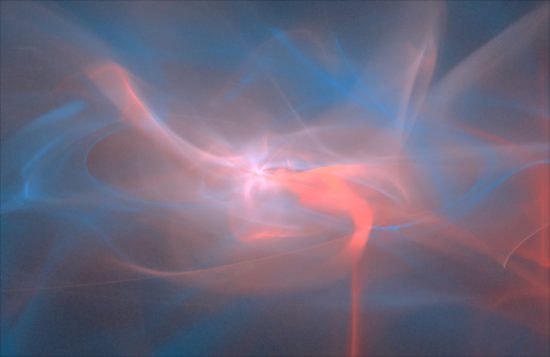
“Dark Energy”. Fractal by Stephen Smith.
Apr 30, 2018
What causes astronomers to think that space is expanding?
“The greatest mistake in my opinion, and the one we continually make, is to let the theory guide the model. After a ridiculously long time it has finally dawned on me that establishment scientists actually proceed on the belief that theories tell you what is true and not true!”
— Halton Arp (March 1927 – December 2013)
Most of the mass of the Milky Way, as well as that of other spiral galaxies, is in the central bulge, so if stars in the arms revolve because of gravity, they would slow down as they got farther from the center. Instead, stars in the Milky Way demonstrate a more-or-less constant velocity. This is known as a “flat rotation curve”, as a recent Picture of the Day pointed out, although astronomers have a difficult time deciding if galaxies are discrete “things” that rotate like solid disks, or if they are a collection of stars that revolve.
Recently, astronomers using the European Space Agency’s XMM-Newton space telescope reported that nearby galaxies appear to contain three times less luminous matter than expected, while the Milky Way contains less than half of what was expected. Jiangtao Li of the University of Michigan said:
“This has long been a mystery, and scientists have spent a lot of effort searching for this missing matter.
Why is it not in galaxies — or is it there, but we are just not seeing it? If it’s not there, where is it? It is important we solve this puzzle, as it is one of the most uncertain parts of our models of both the early Universe and of how galaxies form.”
The Milky Way rotates much faster than visible matter alone can account for. This is a mystery that contradicts conventional theories about galaxy evolution. If astronomy were actually “science” and not speculation, “contradict” would mean “falsify”, and they would start over. They would consider other assumptions. That would throw a spanner in the works, however, undermining textbooks, discrediting published papers, and jeopardizing careers.
One alternative that is different from the gravity model is Dr. Anthony Peratt’s laboratory investigations. He demonstrated interacting Birkeland currents that rotate around each other at constant velocities, with plasma trails morphing into spiral “arms”. Plasma accumulated between the arms into a “bulge” that eventually swallowed the currents. At the grand scale, could this be the motive force for galactic rotation?
In 1998, Saul Perlmutter and Adam Riess of the Lawrence Berkeley National Laboratory and Brian Schmidt from the Australian National University projects independently discovered what was later called “dark energy”, an indication that the expansion of the Universe was accelerating. Since it is based in Big Bang theory, the expansion of the Universe is challenged by Electric Universe concepts.
Electric Universe theory predicts that more stars will occur where there are greater flows of electric charge, which could also initiate a greater number of stellar explosions with anomalous luminosities and high redshifts. That would make highly charged, nearby objects undergoing electrical discharges look like remote, high redshift supernovae that are too bright for their distances. One can imagine the theoretical problems that would result from that misinterpretation.
Cosmologists made their first mistake when they ignored electricity as an active force. X-rays from ion excitation, a range of energy curves, and (sometimes) gamma-rays are properties of lightning bolts. Computer simulations demonstrate that plasma phenomena are scalable over several orders of magnitude.
“All of the ‘dark’ things in astronomy are artifacts of a crackpot cosmology. The ‘dark energy’ model of the universe demands that eventually all of the stars will disappear and there will be eternal darkness. In the words of Brian Schmidt, ‘The future for the universe appears very bleak.’ He confirms my portrayal of big bang cosmology as ‘hope less’.” — Wal Thornhill
Stephen Smith












